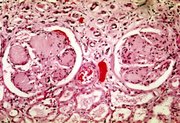To the Editor:
A POEM in the February 2005 issue ("ARB no better than ACE inhibitor for prevention of nephropathy progression," J Fam Pract 2005; 54:108-109) discussed the head-to-head randomized double-blind trial from the New England Journal of Medicine by Barnett and colleagues, "Angiotensin-receptor blockade versus converting-enzyme inhibition in type 2 diabetes and nephropathy." (1) This POEM would be better titled "ARB as good as ACE inhibitor" because the study was a non-inferiority trial, designed to prove that the angiotensin receptor blocker (ARB) was "non-inferior" to the angiotensin-converting enzyme (ACE) inhibitor in preventing the progression of diabetic nephropathy. In the age of biases with drug company--sponsored research protocols, we must also be mindful of the language used in reporting results back to the target audience.
Currently, non-inferiority trials are much less common than standard randomized clinical trials (RCTs) for a number of reasons. First, non-inferiority trials are held to more stringent standards than RCTs. The non-inferiority trial is powered to have a 95% chance of detecting a predetermined maximum acceptable difference between the treatment arms that is "clinically insignificant," thus changing the null hypothesis to state that there is a significant difference between the 2 treatments.
Second, these trials must be conducted in a very meticulous manner, since any factor that would be important for generality in an RCT, including a broad range of ages, severity, ethnicities, comorbid conditions, would increase the "noise" in a non-inferiority trial, and subsequently increase the likelihood that the trial would find no difference between the 2 treatments.
Third, due to the number and range of medications already available, new medications are increasingly being developed for indications in which a placebo control group would be unethical, thus necessitating head-to-head comparisons. Examples include comparing 2 selective serotonin reuptake inhibitors in patients with suicidal ideation, or comparing 2 anticoagulants in preventing stroke in atrial fibrillation. (2)
As newer treatments become available, clinicians will want to know 1) is it better than what they are using now, and 2) if not, is it as good as what they are using now ("non-inferior") and preferable for some other reason. (3) Using an alternative treatment rather than the standard treatment may be justified if it is proven that the alternative is more advantageous with respect to availability, safety, or cost. In this study, the ARB is shown to be non-inferior to the ACE inhibitor in preventing diabetic nephropathy. The reader must now decide if this "as good as" drug is worth using in their patient population.
Vanessa Greenwood, MD, Combined Resident Family Medicine/Psychiatry, University of California at San Diego Medical Center
Dr Mark Ebell responds:
The author makes a good point, and I thank her for her attention to detail. I agree with her point that the drugs are equivalent from the perspective of efficacy.
Many physicians, perhaps the majority, behave as if they believed that ARBs are preferred to ACE inhibitors.
However, ARBs are not safer; are not better tolerated (except by those patients with a cough caused by ACE inhibitors); are not simpler to take; and are certainly not cheaper. I would argue that since ARBs are similarly effective but much more expensive, not only are they no better than ACE inhibitors, they are actually worse.
The point of POEMs is not only to convey the results of research accurately, but to evaluate its relevance and validity, and put it into context. I feel that my version of the statement does this better than the suggested alternative.
Mark H. Ebell, MD, MS, InfoPoems, Inc
REFERENCES
(1.) Barnett AH, Bain SC, Bouter P, et al. Angiotensin-receptor blockade versus converting-enzyme inhibition in type 2 diabetes and nephropathy. N Engl J Med 2004; 351:1952-1961.
(2.) Stroke prevention with the oral direct thrombin inhibitor ximelagatran compared with warfarin in patients with non-valvular atrial fibrillation (SPORTIF Ill): randomized controlled trial. Lancet 2003; 362:1691-1698.
(3.) Sackett DL. Superiority trials, non-inferiority trials, and prisoners of the 2-sided null hypothesis. Evidence Based Med 2004; 9:38-39.
COPYRIGHT 2005 Dowden Health Media, Inc.
COPYRIGHT 2005 Gale Group



